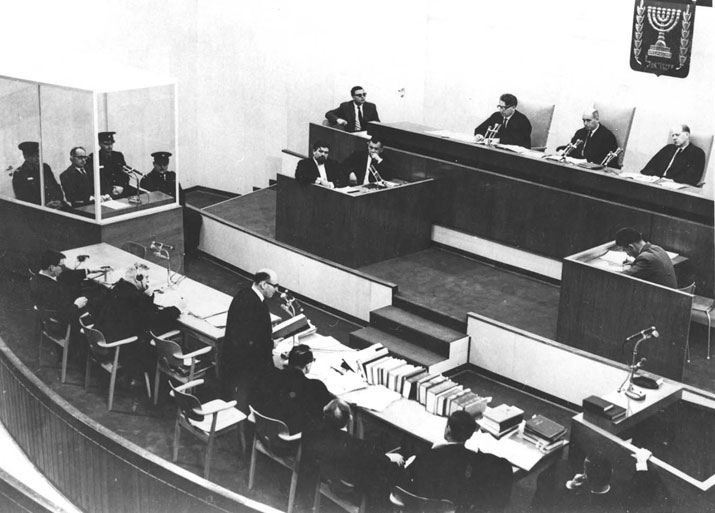User:Natasa Siencnik/project3
Morality Play
Introduction from Essay
At five, at exactly five... Hattie and I sit before the TV and we become a silent movie... . A small-faced man narrates. His voice weak and light. An advertisement disguised as not an advertisement from a Jewish real-estate firm. None of that seems to matter. I begin to sweat. My heart pounds. . . . We sit on hard kitchen chairs drawn up before the TV, watching. As if putting ourselves to school. The eyewitnesses, their faces designed into masks, wrinkled... . Their voices, in translation, disembodied. There is something... about the way we both move ― or don’t move―while we are watching. Hattie and I are an experimental, silent film reacting to a film on TV. The old speeded-up, slowed-down, silent film. ― Norma Rosen, Touching Evil
The experience of witnessing the war crimes trial of Adolf Eichmann described in Norma Rosen's novel "Touching Evil" is one shared by many others. In 1961, Eichmann, former SS officer and highest ranking figure in the Nazi hierarchy responsible for facilitating mass deportation and the extermination of European Jewry, was charged and tried before an Israeli court with committing crimes against the Jewish people and humanity. The case of multiple controversies was the first telecast of actual courtroom proceedings and with the distribution to many countries reached an international audience. Especially in America, the trial was daily broadcasted over a period of several months, thereby inscribing and framing the collective memory.
From the very beginning the trial was conceptualized as a symbolic performance, supported not only by the staged design of the courtroom, cinematographic aesthetics of the film footage, but also by the role the audience was given. The morally charged act of witnessing the trial as a drama, became a formative role in establishing the Shoah as part of collective history. As Hans Kellner describes: "Creating a reader for the Holocaust has been the work of writers, artists, filmmakers, poets, and historians since the end of the war." (Shandler, 1999) However, the explicit staging of the trial as a morality play also leads to the question wether the Shoah can or should have an aesthetic dimension?
Reflecting on the performative nature of the Eichmann trial Susan Sontag argues that tragedy has become "a form of history. Dramatists no longer write tragedies. But we do possess works of art (not always recognized as such) which reflect or attempt to resolve the great historical tragedies of our time. […] As the supreme tragic event of modern times is the murder of the six million European Jews, one of the most interesting and moving works of art of the past ten years is the trial of Adolf Eichmann in Jerusalem in 1961." (Shandler, 1999)
Adorno's well-known comment from 1949, that "writing poetry after Auschwitz is barbaric", was answered by the German theater maker Peter Weiss by re-enacting parts of the so-called Auschwitz trials from 1963 to 1965 in Frankfurt am Main in his play "The Investigation". Premiered in 1965, Weiss uses the performative nature of trials in general and utilizes the documents as protocols, files, letters, statistics and interviews as his source material. Whereas the Eichmann trial was deliberately conceptualized as a symbolic performance with a highly theatrical approach, the documentary theater "attempted to renounce as comprehensively as possible all fictionalization in drama" (Wüst, 2005).
In the following essay both cases shall be discussed further to examine narrative and aesthetic strategies in the representation of the Shoah, reflecting the impact of mediation on the creation of moral and memory, considering the trial as a form of dramaturgy.
Concept
Norma Rose Hannah Arendt Aveva Fleischmann

